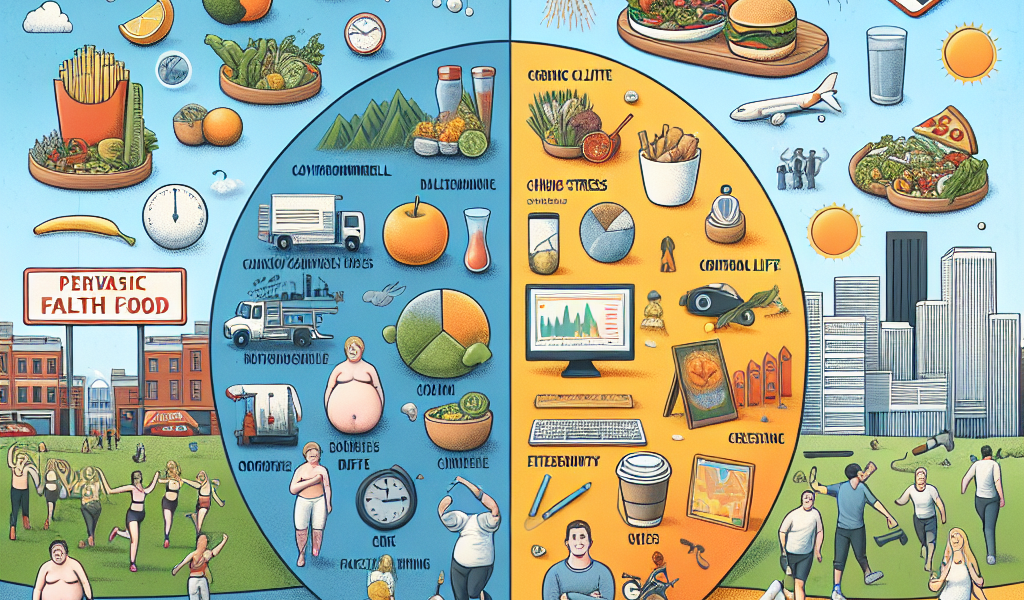What Is One “outside Of The Body” Factor That Contributes To Obesity?
In a world rife with health challenges, the silent yet mighty villain, obesity, continues to claim many unsuspecting victims. Cries of advocacy and information bursting with adipose facts only barely scratch the surface of this severe threat to longevity. Though many suspect guilty dietary habits and low physical activity to be the main culprits, seldom do we turn the looking glass towards the external, and perhaps, plague-like factors fueling this growing epidemic. Brace yourselves as we unravel one such insidious contributor which lies not within the realm of our physical being but lurks on the periphery- a potent entity adding to the burgeoning statistics of obesity.

Defining Obesity
What is obesity?
When we venture into the territory of understanding obesity, we’re essentially navigating the complex intersection of health, lifestyle, and genetic factors. At its core, obesity refers to the excessive or abnormal accumulation of body fat, to an extent that it might impair health. It’s not just about body image or cosmetic appearances; obesity fundamentally taps into a range of physical problems and raises the risk of various diseases, thereby affecting the quality and longevity of life.
What are the classifications of obesity?
As we delve deeper, we stumble upon different classifications of obesity. The easiest way to categorize obesity is by evaluating the Body Mass Index (BMI). As per the World Health Organization, a BMI greater than or equal to 30 is considered obese. This definition is further nuanced into classes – Class I (30 to <35), Class II (35 to <40), and Class III (40 or higher), each bringing its own set of health risks and physical challenges.
Measurement and indicators of obesity
Gauging obesity is not a singularly dimensional process. On the surface, it might appear that body weight is the ultimate indicator, but in actuality, indices such as BMI, waist circumference, and waist-hip ratio play a pivotal role in understanding the intensity of obesity. Body Mass Index is the individual’s weight in kilograms divided by the square of their height in meters. The waist-hip ratio compares the size of the waist to that of the hips to understand body fat distribution, while the waist circumference can help identify abdominal obesity.
Overview of Obesity Causes
Genetics and obesity
As we quest for the causes behind obesity, it is impossible to overlook the role of genes. Certain genetic predispositions can make individuals more likely to gain weight. Some genetic mutations might affect appetite and metabolism, possibly leading to obesity. However, we must note that genes alone can’t be blamed; environmental and behavioral factors are equally significant.
Hormonal influence on obesity
Skating further along the causes of obesity, we tip-toe into the realm of hormonal influences. Certain conditions like hypothyroidism and Cushing’s syndrome can interfere with the body’s metabolic rate, promoting weight gain. Hormones also play a role in how your body stores fat and in governing hunger cues.
Childhood habits leading to adult obesity
Diving into our past also reveals certain truths about our present; childhood habits can guide weight patterns during adulthood. Early eating habits, sedentary lifestyle, or even the lack of breastfeeding can lay the groundwork for potential weight issues later in life.

The Conventional Internal Factors
Poor diet and obesity
Peeping into our dietary choices provides an apparent understanding of obesity. An overindulgence in high-calorie foods, especially those high in sugar and fats, adds up extra pounds. A poor diet doesn’t necessarily imply overeating alone; it’s also about a lack of essential nutrients and balanced meals.
Sedentary lifestyle and obesity
Imagine us as energy machines; we consume calories for functioning and burn them through physical activities. Inactivity or a sedentary lifestyle means less burning of calories which may lead to their storage as fat, spawning obesity. Modern technological conveniences have substantially reduced our daily physical activity, thereby amplifying the obesity challenge.
Medical conditions leading to obesity
Unearthing the labyrinth of medical influences, we find certain illnesses fueling obesity. Conditions such as Prader-Willi syndrome, Bardet-Biedl syndrome, and Cohen syndrome can serenade obesity. Also, medications for psychiatric conditions, diabetes, or seizures might cause weight gain.
The Unconventional External Factor – Environment
Definition of ‘outside the body’ factor
Widening our horizons brings us in touch with factors outside our body that contribute to obesity. These are extrinsic contributors—elements in the environment, the societal fabric, our cultural norms—that can unknowingly coax us towards obesity.
Environmental influence on obesity
At its simplest, our environment blankets everything around us—from the air we breathe, the stress we experience, to the food we consume. Exposure to certain pollutants, low availability of fresh produce, widespread fast-food joints, and advertising tactics imprints a lasting impact on our weight and health.
Link between environment and obesity
The stitches between obesity and the environment are intricate and multifaceted. An unhealthy environment subtly sets the stage for unhealthy choices, heralding obesity. For example, a neighborhood lacking safe spaces for physical activity or grocery stores offering fresh produce can indirectly nudge towards weight gain.

Effects of Urbanized Living
Urban vs. rural obesity rates
When we compare urban and rural obesity rates, we step into a contradiction. Rapid urbanization offers access to healthcare and diverse food options but also embeds sedentary lifestyles, stress, and unhealthy food choices. Consequently, urbanites may have higher obesity rates.
Lifestyle changes in urban settings
While traditional agrarian lifestyles demanded physical labor, urban life is predominantly desk-bound. Commuting modes have shifted from walking or cycling to motorized transport. Leisure activities are increasingly indoors, glued to screens. All these changes teeter urban dwellers towards the obesity scale.
Land-use patterns and obesity
The design of our cities has further convoluted the obesity crisis. Mixed land use, where residential areas coexist with commercial zones, encourages walking and reduces obesity. Conversely, urban sprawl that necessitates car-based mobility significantly boosts obesity rates.
Food Environment and Accessibility
Access to unhealthy food and obesity
In the current food environment, unhealthy options are often cheaper, more readily available, and heavily marketed, creating an easy pathway to obesity. Imagine a superhighway of fast-food chains against a dirt road of salad bars— it’s an uneven playing field.
The role of supermarkets and restaurants
Supermarkets and restaurants significantly shape our meal patterns and choices. The easy availability of high-calorie, low-nutrient meals and large portion sizes at these outlets create a fertile ground for overeating and subsequent weight gain.
Food deserts and obesity
Food deserts—areas with scarce healthy food options— accentuate the obesity problem. When we lack access to grocery stores offering fruits, vegetables, and whole grains, we resort to convenience stores or fast-food joints stocking processed, calorie-laden foodstuffs, paving the way to obesity.

Social and Cultural Environment
Social norms and obesity
As we survey our social landscapes, we spot norms and stereotypes that potentiate obesity. Sedentary occupations, often seen as ‘prestigious,’ celebratory feasts, and big meals as a hospitality symbol contribute to weight gain.
Cultural attitudes towards food and exercise
Our cultural lineage shapes our attitudes towards food and activity. In some cultures, copious meals signify opulence, while in others, thinness equates to illness. Such perceptions can foster unhealthy eating behaviors and poor activity levels, accelerating obesity.
Media influence on obesity
Mass media, with its omnipresent clout, sways our perceptions and behaviors. Advertising high-sugar, high-fat foods, and portraying thinness as the ideal beauty standard can trigger unhealthy eating patterns and weight gain.
Built Environment and Physical Activity
The role of physical activity in combating obesity
Physical activity is a robust tool in our arsenal against obesity. Regular exercise helps burn calories, build muscle, and boost metabolism, all steering us away from the perilous shores of obesity.
How built environment affects physical activity
Our concrete jungles, the built environment, affects our physical activity levels. Cities riddled with traffic, lacking pedestrian sidewalks or bicycle paths, or deficient in well-maintained parks can discourage leading an active lifestyle.
Urban planning and obesity rates
Effective urban planning can make or break our fight against obesity. Infrastructure that promotes walking or cycling, accessible public transport, and ample green spaces for recreation can encourage more physical activity, thereby curtailing obesity rates.

Policy and Legislative Factors
Government policies and obesity
Policies, at the government level, wield a substantial influence on obesity rates. Public policies regarding the food industry, advertising rules, infrastructure development, and healthcare accessibility can either nurture or nudge obesity.
Examples of policies impacting obesity rates
Specific policies such as taxing unhealthy food, subsidizing fresh produce, regulating food advertisements aimed at children, or funding for public parks and exercise spaces have shown potential in mitigating obesity.
The role of legislation in healthy lifestyle promotion
Legislation can play a pivotal role in promoting a healthy lifestyle. From regulating food labels, banning trans fats, to enforcing physical education in schools, legislative decisions can contribute significantly to obesity prevention.
Strategies to Counter Environmental Factors
Approaches to make healthy eating accessible
Countering environmental factors requires strategic efforts, like making healthy eating more accessible. This involves steps like increasing available healthy food outlets, urban farming initiatives, and educational programs about balanced diets.
Promoting active living in urban settings
Urban settings need to foster active living, providing infrastructure for walking, cycling, ample community parks, gyms, and recreational centers. Such steps can drive people to espouse more active lifestyles, thereby countering obesity.
Role of government in obesity prevention
The government’s role in obesity prevention is colossal. Apart from creating health-conscious policies, the government can invest in research and interventions, enhance healthcare accessibility, and launch awareness campaigns to prevent obesity.
In summary, our fight against obesity requires a thorough understanding of its complexities—a blend of genetic, hormonal, lifestyle, environmental, and policy-related factors. However complex or challenging the terrain may be, with informed strategies and collective will, a healthier future is within our reach. And that healthier future begins with each one of us making mindful decisions about our food, activity, and lifestyle.


Pingback: How Does Breast Milk Decrease Risk Of Obesity And Diabetes Uslme Forum